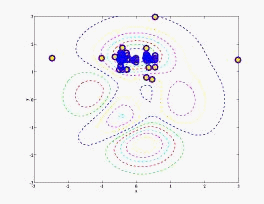
see also: Ms. Guidance on Robotics
PART 1
PART 2
Ms. Guidance on Artificial Life
GENETIC ALGORITHMS
AUTONOMOUS AGENTS
FUZZY SYSTEMS
NEURAL NETWORKS
CELLULAR AUTOMATAS
GENETIC ART

see also: Ms. Guidance on Robotics
PART 1
PART 2
Ms. Guidance on Artificial Life
GENETIC ALGORITHMS
AUTONOMOUS AGENTS
FUZZY SYSTEMS
NEURAL NETWORKS
CELLULAR AUTOMATAS
GENETIC ART
![]() MIT Artificial Intelligence Laboratory Home Page
MIT Artificial Intelligence Laboratory Home Page
1. AI Resources
3. MIT AI lab projects and publications
2. Library catalogs and information
Including: Robotics and Machine Vision, Learning Systems, Virtual and Enhanced Reality,
Computing Systems and Environments, Software Agents
![]() CMU Artificial Intelligence Repository
CMU Artificial Intelligence Repository
![]() Genetic Algorithms Research and Applications Group (the GARAGe)
Genetic Algorithms Research and Applications Group (the GARAGe)
The GARAGe at Michigan State University is a multi-disciplinary unit interested in the application of Genetic Algorithms and Genetic Programming to real-world problems, as well as fundamental research on GA and GP. They have a number of projects including: parallelization of GAs/GPs; multiple population topologies and interchange methodologies; scheduling applications.
This library provides the application programmer with a set of C++ genetic algorithm objects. The library includes tools for using genetic algorithms to do optimization in any C++ program. It is maintained by Matthew Wall.
![]() Uncertainty in Artificial Intelligence
Uncertainty in Artificial Intelligence
![]() IEEE-Expert94, Design Using Genetic Algorithms: Some Results for Composite Structures.
IEEE-Expert94, Design Using Genetic Algorithms: Some Results for Composite Structures.
![]() PDP94, Coarse-grain Genetic Algorithms, Categorization and New Approaches.
PDP94, Coarse-grain Genetic Algorithms, Categorization and New Approaches.
![]() "Genetic
Programming for Articulated Figure Motion"
"Genetic
Programming for Articulated Figure Motion"
Applying the AI technique known as Genetic Programming (GP) to control the motion of articulated figures. This allows the system to automatically generate life-like motion for jointed figures. The human animator must provide a fitness function which rates the motion which the system generates.
![]() Animation of the evolution of the GA population when optimizing a multimodal function
Animation of the evolution of the GA population when optimizing a multimodal function
by Juha Haataja

This page describes the
current research being conducted by DIAG, the Distributed Intelligent
Agents Group, at the University of
Michigan, Department of Electrical Engineering and Computer Science,
Artificial Intelligence
Laboratory.
![]() Distributed Intelligent Agents Group
Distributed Intelligent Agents Group
![]() What Your Computer Really Needs to Know, You Learned in Kindergarten. (Edmund H. Durfee)
What Your Computer Really Needs to Know, You Learned in Kindergarten. (Edmund H. Durfee)
The Distributed Artificial Intelligence Laboratory
is part of the Computer Science Department
at University of Massachusetts. You
can find specific information there about the research,
publications and presentations
![]() The Distributed Artificial Intelligence Laboratory
The Distributed Artificial Intelligence Laboratory
![]() Rationality in Decision Machines
Rationality in Decision Machines
...If an agent [2] has knowledge that one of its actions will lead to one of its goals, then the agent will select that action.
This formulation can be criticized on several grounds, foremost of which is that it embodies, logical rather than economic
rationality (Doyle, 1992). But let us put aside such concerns and consider the perspective that a rationality principle of this
general form takes on computing machines. The relevant output identified by this principle is an action selection. Thus,
action selections, or in effect, actions, are the products of a knowledge-level machine....
![]() What is a Fuzzy Expert System? by Eric Horstkotte
What is a Fuzzy Expert System? by Eric Horstkotte
CLIPS is an expert system shell developed by NASA.
The IIT of the NRC has developed FuzzyCLIPS, an enhanced version of CLIPS that supports Fuzzy Logic. FuzzyCLIPS is
available without charge.
![]() FuzzyCLIPS
FuzzyCLIPS
Genetic-Adapt FuzzyWare (GAF) allows users to generate a fuzzy control system by simply defining
the inputs, outputs, data set, and initial rule sets. GAF uses genetic
algorithm to derive proper rules and fuzzy sets from the initial rules.
By changing, adding, deleting rules and fuzzy membership sets, the genetic
algorithm automatically adapts and optimizes the fuzzy control system.
![]() Adaptive fuzzy logic using Genetic Algorithms
Adaptive fuzzy logic using Genetic Algorithms
![]() Yahoo Search - Science:Computer Science:Artificial Intelligence:Fuzzy Logic
Yahoo Search - Science:Computer Science:Artificial Intelligence:Fuzzy Logic
Neural Network Reports: For each report, both an abstract and the complete report are available!
![]() Neural Network Hardware (Clark Lindsey at CERN)
Neural Network Hardware (Clark Lindsey at CERN)
![]() Neural Networks at Pacific Northwest
National Laboratory (PNNL)
Neural Networks at Pacific Northwest
National Laboratory (PNNL)
Listing of neural network papers from PPNNL. These papers may be freely downloaded and distributed provided that proper referencing to the original source of publication is made.
Neural Network Software and Hardware
A good list of Journals
![]() Neural Adaptive Control Technology (NACT)
Neural Adaptive Control Technology (NACT)
The Project aims at a synergy of adaptive control and neural networks. Similarities of both technologies on an abstract conceptual level constitute a basis for fundamental, engineering orientated research. Basic aspects of the fusion of technologies are investigated in the context of multiple computing agents and industrial automation environments.
